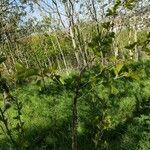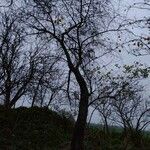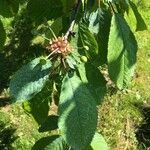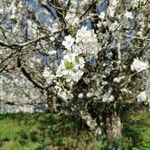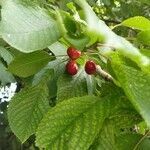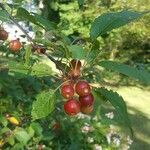Deciduous, suckering, rounded tree, 4-6-(10) m high when mature, not armed; trunk short; primary branches ascending; secondary branches spreading, sometimes pendulous. Lf petiole 12-30-(40) mm long, glabrous; blade ± thin, obovate to broadly elliptic, 40-120 × 25-50 mm, short-acuminate or cuspidate at apex, broadly cuneate to rounded at base, glabrous or with a few long hairs above, glabrous below or occasionally with a few hairs at base of lateral veins, 1-2-serrate with teeth blunt (sometimes with a short dark cusp); stipules triangular, acuminate, early deciduous. Fls in umbel-like clusters of (1)-2-4, on very short shoots, not fragrant, pendent; pedicels 10-20 mm long, glabrous. Hypanthium broadly campanulate; sepals triangular, 3-5 mm long, blunt, glabrous and greenish purple, becoming reflexed. Petals 5, spreading, orbicular, 8-12 mm diam., very shallowly emarginate, white. Stamens ± = to petals; filaments whitish. Fr. 10-17 mm diam., globose, glabrous, dark red, sour; stone smooth.
More
A small deciduous tree. It grows 2-8 m high. It is a broad spreading shape. The bark is purple-brown and has orange lenticels across it. The leaves are oval and have a blunt point. They are 7.5 cm long by 5 cm wide. They are double toothed. The leaf stalks are without glands and are hairless. The buds are cone shaped. They are shiny reddish-brown. The flowers are white and in small long stalked clusters. These are on short leafy shoots. The flowers are 2 cm across. The fruit are 2 cm across. They are bright red to black.
Tree to 10 m, usually with broadly rounded crown; lvs ovate-elliptic to obovate, 5–9 cm, acute, soon glabrous beneath, serrate or doubly serrate, the teeth usually wider than high, rounded, with a gland near the sinus; fls several in a sessile umbel, on pedicels 2–3 cm; sep glabrous; pet 10–15 mm; fr globose, 1.5–2 cm, bright red, tart; stone subglobose; 2n=32. A cultigen thought to be derived by hybridization of P. avium with P. fruticosa; occasionally escaped from cult. in our range.
It is a cold temperate plant. In the Indian Himalayas it grows between 3,000-3,500 m above sea level. It suits hardiness zones 3-9.
More
Hedges in S. England. Roadsides, thickets, woodland borders, abandoned fields; at elevations up to 1,000 metres.
Fruit can be eaten raw. They are acidic. They are often cooked into pies, preserves, puddings, and canned. They produce a colourless juice. The seeds yield an oil used in salads. The crushed seeds in a muslin bag are used to flavour jam. The fruit are candied (crystallised) and also preserved in syrup or brandy. They are processed into jam. They are used for cherry brandy and liqueurs. The leaves are used as a substitute for tea. They are also added to lacto-fermented cucumbers.
